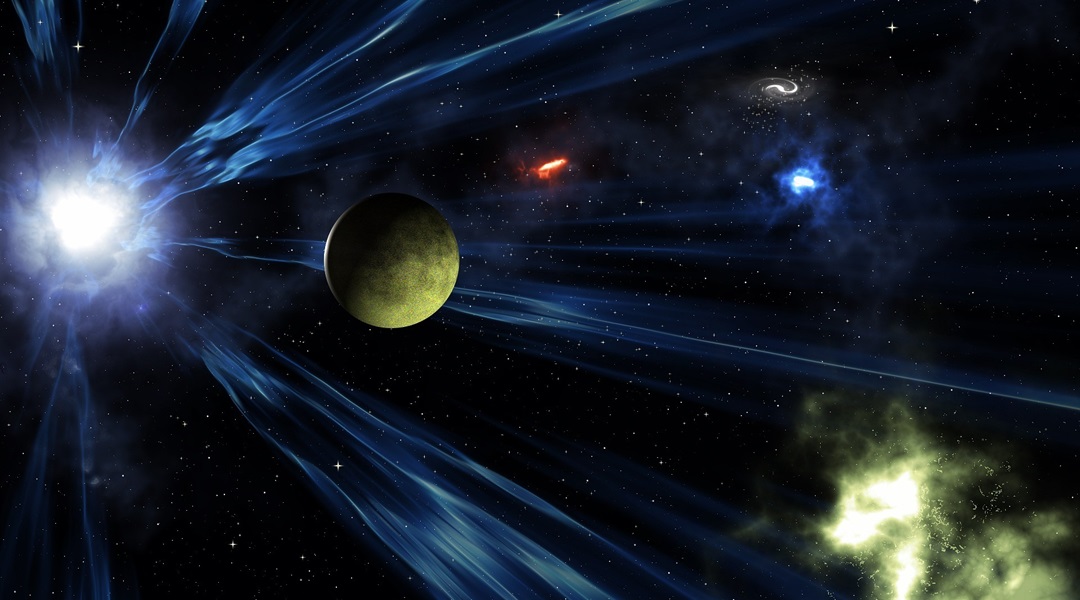Extra dimensions at the microscale could be tested experimentally within 3-5 years.
Our universe may be hiding extra dimensions just beyond the reach of current experiments — and they could be the key to unlocking two of the most stubborn mysteries in physics.
A new theoretical study by Professor Dieter Lüst of Ludwig-Maximilians-Universität München and collaborators proposes that space contains two additional dimensions, each about a micron in size. These hidden dimensions, they argue, could help explain why the forces and energies in the universe differ so dramatically in scale and why the universe’s vacuum energy is so extraordinarily small.
Two hierarchy problems
The first of these puzzles, known as the gauge hierarchy problem, asks why the energy scale of the Standard Model — the framework describing known particles and forces — is so much smaller than the scale at which gravity becomes strong.
“The gauge hierarchy problem is the question, why the electroweak mass scale of the Standard Model is roughly of the order of a few hundred GeV or say 1 TeV, which is about 16–17 orders of magnitude smaller than the Planck scale,” says Lüst in an email.
The Planck scale — about 1019 gigaelectronvolts (GeV) — is derived by combining the speed of light, Newton’s gravitational constant, and Planck’s constant, which governs quantum effects. In everyday units, the Planck mass is around 2×10−8 kilograms, roughly the weight of a grain of sand. It represents the energy at which gravity’s quantum effects are expected to be as strong as the other fundamental forces and is often considered the most fundamental mass in physics, setting the natural scale for all other masses. From a theoretical standpoint, particle masses “should” be closer to this value. The fact that the Higgs boson’s mass is 16–17 orders of magnitude smaller is one of the most striking mismatches in physics.
The second puzzle, the cosmological hierarchy problem, is even more extreme. It concerns the vacuum energy (the energy of empty space), which drives the accelerated expansion of the universe. “It is the question why the measured vacuum energy of the universe is about 120 orders of magnitude smaller than the Planck mass,” Lüst explains.
Extra dimensions could help
Lüst and his colleagues propose that the key may be two extra dimensions hidden within our universe, each only a micron across. These extra dimensions would subtly alter how gravity behaves at very small distances, changing the way the known forces relate to one another.
In their model, the presence of two such “dark dimensions” lowers the fundamental scale of gravity to around 10 teraelectronvolts (TeV), which is just above the energies reached by the Large Hadron Collider. That is far below the scale suggested by conventional theories of gravity, and much closer to the energy range of the Standard Model of particle physics.
“With the natural cutoff of the Standard Model of the order of 10 TeV, the gauge hierarchy problem can be relaxed,” Lüst says.
The theory also naturally accommodates the exceptionally small vacuum energy that drives the universe’s expansion by lowering the true fundamental scale of gravity. If the real Planck mass is around 10 teraelectronvolts rather than the enormous value suggested by conventional gravity, the gap between the vacuum energy expected from theory and the tiny value measured in nature is drastically reduced. This links the cosmological hierarchy problem to the same underlying structure that could also ease the Higgs mass puzzle.
Beyond these two puzzles, the extra dimensions could open a new route to understanding dark matter, the invisible substance that outweighs normal matter in the universe by more than five to one. “The dark dimension scenario with one or two dark dimensions has the advantage that it can also offer a nice way to explain dark matter particles either in the form of KK particles,” says Lüst. KK, or Kaluza–Klein, particles are hypothetical massive particles that could result from the geometry of extra dimensions.
Putting the idea to the test
The proposal is not purely abstract. Lüst points out that experiments sensitive enough to detect deviations from Newton’s law of gravity at micron scales could confirm or rule out the existence of such dimensions.
“The dark dimension scenario with one or two micron sized extra dimensions can be tested by new, very precise measurements of the Newtonian force at the micrometer scale,” he says. A team in Vienna is already developing such an experiment, with results potentially just a few years away. “I talked to the experimentalist and the time scale is possibly 3–5 years.”
The two-dimensional version of the theory could also leave signatures in high-energy collisions. “The scenario with two dark dimensions can be possibly tested by the next High-Luminosity run of the LHC, which is exploring the energy scale of about 10 TeV,” Lüst notes.
Cosmological implications
While the model is still in its early stages, Lüst’s team is working to embed it into a more complete framework of fundamental physics. “We are working on how two extra dimensions of micron size can be derived from string theory, which is commonly believed to be the ultimate theory of quantum gravity and other fundamental interactions,” he says. They are also studying its implications for the evolution of the universe, including whether it could support a form of “dynamical dark energy” that changes over time.
If the theory proves correct, it would reshape our understanding of the universe’s structure on the smallest scales, and offer a unified explanation for two of the most perplexing gaps in modern physics.
“This is very exciting,” Lüst says. “We might be able to test the very shape of our universe — and its hidden dimensions — in the lab.”
Featured image by mike lacoste via Pixabay

